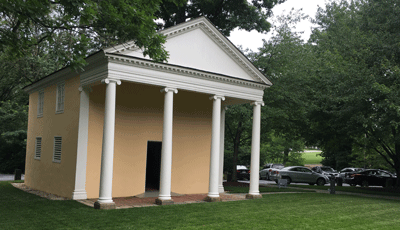World-renowned Baltimore artist and educator Oletha Devane is featuring a new installation, “Traces of the Spirit,” at the Baltimore Museum of Art (BMA) through October 20, 2019.
Oletha Devane is featuring a new installation, “Traces of the Spirit,” at the Baltimore Museum of Art (BMA) through October 20, 2019.
The exhibition is a stunning collection of monoliths, totems and wall art meticulously crafted in very fine detail by Devane utilizing a wide array of colors; textures; paper; cloth; beads; shells; plastic; wood; metal; various-sized figurines and masks; and reflective glass, some materials ingeniously re-purposed, to create unique art well-suited for showcasing at a historic classic art venue.
Housed at the iconic Spring House, circa 1812, a former slave abode acquired by the Baltimore Museum of Art in 1932 and located on the western grounds of the museum’s campus, the one-room structure is a suitable metaphor intimately linking Devane’s assembled works to the African Diaspora. The Traces of the Spirit exhibition is further accentuated using light and sound in the installation, bringing the exhibit to life.
The sound of flowing water can be heard as if from a nearby river. The sounds were apparently recorded by the artist’s son during a trip to Haiti last year and are intended to signify the various river and ocean voyages that dispersed Africans worldwide over the last several centuries, as explorers and also as slaves.
Jourdan Taylor
The installation is housed at the iconic Spring House, circa 1812, a former slave abode acquired by the Baltimore Museum of Art in 1932 and located on the western grounds of the museum’s campus.
Traces of the Spirit is a must see. The uniqueness and intricacy of the individual pieces do not lend themselves well to written descriptions sufficient to describe their beauty, the emotional, intellectual and spiritual stirrings they evoke, nor the myriad interpretations one might come away with. Every individual piece among the installation speaks eloquently in a unique artistic voice that documents and reveals aspects of Afrocentric history, spirituality and mythology as precisely as any Egyptian hieroglyph.
Religion is a major theme in the installation with several of the works patterned after altars. There are subtler references symbolized by angelic dolls, Gothic-style images and serpents. Thorough appreciation of the artist’s imagination will require observer’s of her work to pay close attention to the detailed mosaic, which comprises every piece. There is magic in the minutiae.
Interestingly, Devane’s works might be viewed as “art” only because they immediately delight the senses and stir the imagination, a feast for the eyes and ears. Her works are beautiful in the way one might view ancient artifacts. Just like traditional artifacts, Devane’s creations are craftily engineered as sophisticated communications devices that happen to be aesthetically appealing.
These are major works of social commentary that have historic roots and contemporary meaningfulness. Devane’s skillful use of a cacophony of materials come together in a visually impressive artistic synergy displaying her keen creative sensibilities and her talent for weaving coherent messaging into works of exquisite art.
A sneak peek at the installation, graced by the artist’s presence, revealed how much historic symbolism is imbued into her individual works, identifying rich cultural strands linking the past to the present, while providing a more multi-dimensional understanding of both.
Despite Devane’s wide array of accolades and professional accomplishments, she may have been discounted in one-regard. She is an amazing raconteur. The anecdotes she shared about her father and other life experiences that have informed her work were themselves compelling and demonstrated an art form. Her work is the artistic equivalent of wisdom and knowledge imparted by an esteemed African griot.


